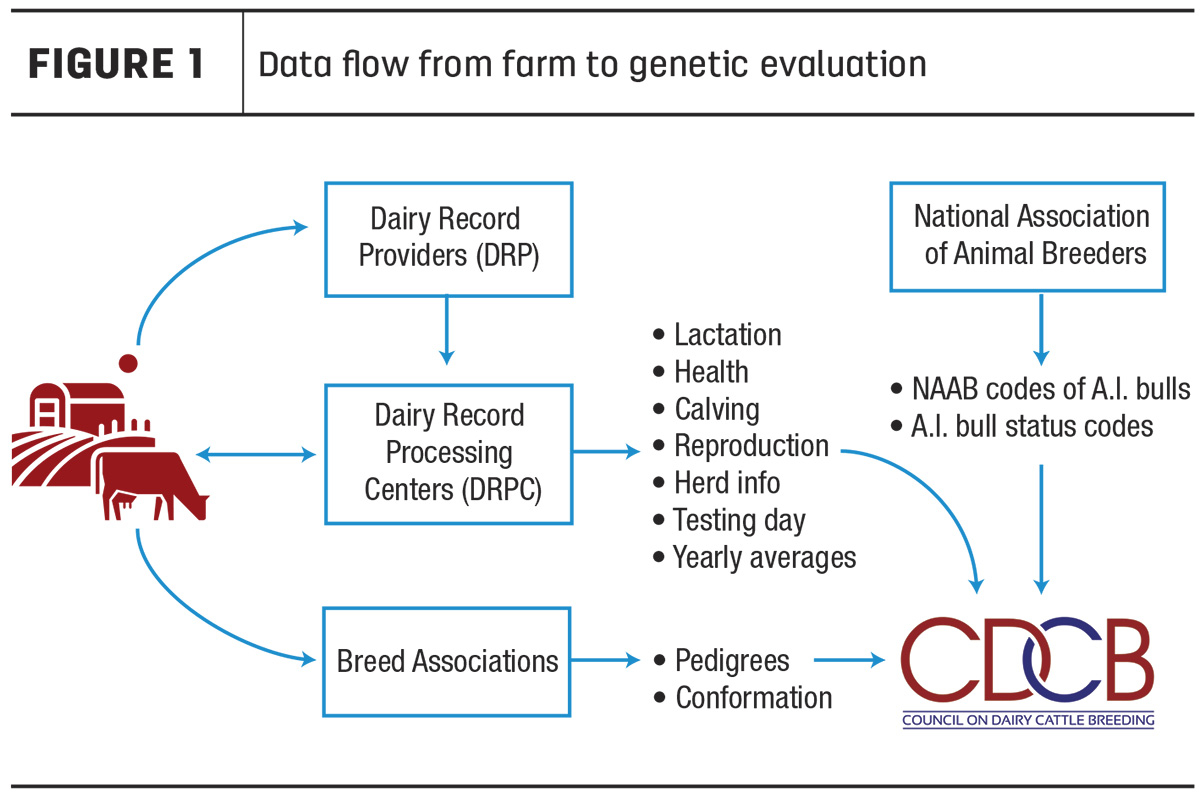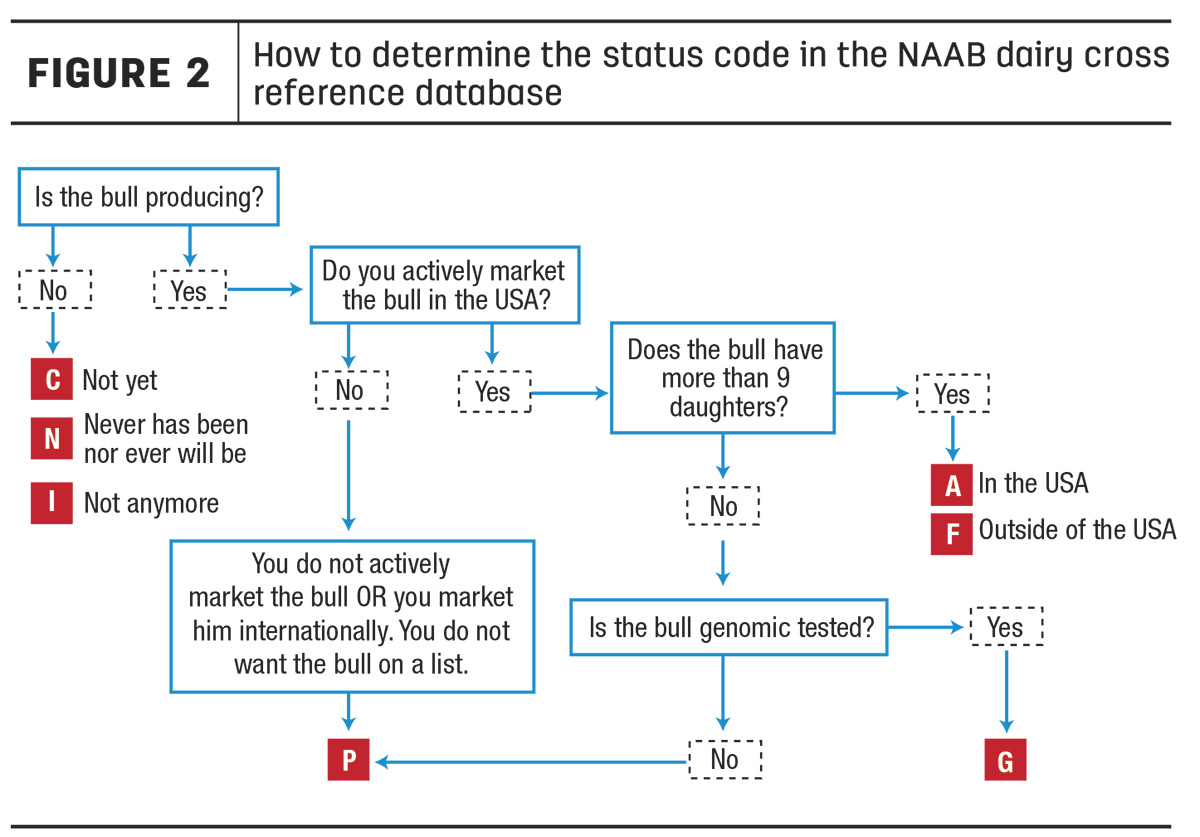U.S. genetic evaluations for dairy cattle are revered worldwide and often considered a golden standard. Thousands of animals receive a U.S. genetic evaluation on a weekly basis. Currently, the genomic database at the Council on Dairy Cattle Breeding (CDCB) holds over 6 million genotypes, of which approximately 500,000 are from bulls.
The U.S. genetic evaluation is open for any bull or female to receive an evaluation. However, with U.S. official values being used heavily for genetic selection and marketing on a global scale, there is a set of regulations in place to ensure calculation, distribution and publication is controlled and fair across the board. Unfortunately, these regulations result in a complicated process that isn’t easy to comprehend.
Let’s lay out the mechanics of the U.S. genetic evaluation system and the conditions to receive a U.S. genomic evaluation on a dairy A.I. bull.
Which bulls can get a U.S. genomic evaluation?
The U.S. has a so-called “open system” for national genetic evaluations. There are no restrictions to receiving an evaluation after fees are paid and appropriate steps are completed with the National Association for Animal Breeders (NAAB) and the CDCB. Because the process is more complicated and involves proprietary data and industry investment, more steps and fees are in place to receive a genomic evaluation versus a traditional evaluation – one without genomics, for non-genotyped animals.
Who are the industry partners involved?
There are multiple organizations that collaborate to realize U.S. genetic evaluations. Throughout the year, these organizations communicate and share data to make sure everything is set up correctly for the genetic values to be calculated and distributed correctly.
Nominators and genotyping labs
Nominators (also referred to as requesters) are the conduit between owners or marketers of animals that wish to receive a U.S. genomic evaluation. Nominators ensure that samples for DNA testing are sent to certified laboratories with correct and complete information. The nominator then receives the genomic results back and delivers this to the animal owner or organization. Often, organizations are both laboratories and nominators. It is important that nominators inform their customers about the fees that could be coming down the road if the bull is used for semen collection.
Dairy records providers (DRPs) and dairy record processing centers (DRPC)
DRPs are state or regional organizations that gather on-farm data. This data is sent to DRPCs, which normalize and standardize the data and records that a producer authorizes to be used in genetic evaluations that are transferred to the CDCB.
National Association of Animal Breeders (NAAB)
The NAAB manages the cross-reference database of A.I bulls. The NAAB code on an A.I bull is an important identifier that allows on-farm data to be linked to the correct sire at CDCB. NAAB sends the A.I. bull data to CDCB, indicates which bulls require a genetic evaluation and which bulls are actively marketed. NAAB also does the accounting of A.I service fees on behalf of CDCB.
Breed associations
The official dairy breed associations submit classification and pedigree data to the CDCB and publish their own total merit indices. The associations receive a list of actively marketed bulls with the NAAB codes from NAAB for each sire evaluation.
CDCB
The CDCB manages the national database of phenotypes and genotypes then calculates and distributes the U.S. genetic and genomic evaluations for dairy cattle. Figure 1 shows how data flows to the CDCB for genetic evaluations.

Genomic preliminary evaluations versus official evaluations
Young bulls can get a preliminary U.S. genomic evaluation for a nomination fee. Results are returned via a weekly unofficial evaluation that allows for immediate mating and culling decisions, followed by a monthly official update. Weekly evaluations are only run for newly genotyped animals or those with corrected conflicts. The difference between the weekly and monthly evaluations lies with how the genetic markers are handled. The marker effects are not updated for the weekly evaluations but are for the monthly official evaluations.
- To receive a preliminary weekly evaluation, the bull must be nominated and have a genotype submitted to CDCB by a certified laboratory.
- Weekly unofficial evaluations for new bulls are returned to the genomic nominators and are publicly distributed by CDCB. Weekly evaluation results on males are for selection purposes only and may not be used for marketing. Female genomic values are not made public and are only returned to the genomic nominators.
- Monthly official evaluations on non-A.I. males are publicly distributed once during their first monthly evaluation and may be used for the marketing of animals. If these results are used for the marketing of semen, this classifies the bull as A.I., which triggers an A.I. service fee.
Bulls used for A.I.
NAAB is the entity that communicates to the CDCB whether a bull is (or is to be) used for A.I. – meaning that frozen semen will be or is collected.
Most A.I. bulls have an NAAB code that is allocated by the bull owner or collection facility. The U.S. A.I. industry is a self-regulated industry, meaning it is not regulated by the government. Instead, the NAAB is the authority the government looks at to ensure important matters, such as traceability of produced frozen semen. The NAAB code is vital in the traceability of semen that is sold both domestically and internationally. As the industry is growing rapidly and more U.S. semen goes into farms worldwide, NAAB has made the reporting of any allocated NAAB uniform code mandatory since January 2021 so it can uphold its responsibility of tracking NAAB uniform codes assigned and printed on semen straws. Note that these codes are sometimes mistakenly referred to as cane codes or bull codes and follow the format XXXAAXXXX, such as 123HO1234. When a bull and code is reported, the entity responsible for managing the bull information in the NAAB database is referred to as its "controller."
Bull status codes
The NAAB reports any dairy bull to the CDCB that is registered in their cross-reference database. NAAB uses bull status codes to categorize the bulls as young (C), genomic (G), proven domestic (A), proven foreign (F) or inactive (I). P status is currently pending re-definition. Previously, it was allocated to progeny-test bulls prior to genomic selection; now the P status is used for bulls that are not desired on U.S. ranking lists. These status codes are important because they determine if the bull is listed as an official A.I. by the CDCB (any status that is not C) and if the bull will appear on industry ranking lists.
Bulls that have the appropriate status code at the NAAB before the database closes (six weeks before the next triannual evaluation) will receive an official genomic evaluation. A U.S. genomic evaluation is published for the A.I. bull when the following conditions are met:
- It is a
- domestic bull with a bull status of C, P, G, A, F or I
- foreign bull younger than 16 months with a status of P, G, A or F
- The bull was enrolled with the NAAB before the closing deadline prior to the next evaluation
- A U.S. genomic evaluation is desired by the bull owner
- There is no history of unpaid invoices
Figure 2 shows how NAAB bull status codes are determined.

Publication of results for A.I. bulls
A.I. bulls for which semen is available (excluding young bulls) only get official values during the CDCB triannual sire evaluations in April, August and December. Triannual evaluation results are public and may be used for marketing of semen but must be from the most recent evaluation and list the source (CDCB) and the evaluation date.
Bulls with an A, F or G status code are considered actively marketed bulls. The NAAB will distribute the NAAB codes and animal information of these bulls to the industry to be placed on industry ranking lists. Every ranking list may have additional requirements, such as reliability thresholds, for listing the bull.
What about A.I. bulls that don't have an NAAB code?
While recommended for optimal data flow, traceability and marketing, it is not mandatory for an A.I. bull to be allocated an NAAB code. Many foreign bulls don’t have an NAAB code. In that case, the bull does not need to be reported to the NAAB. Instead, the bull will be identified at the CDCB as an A.I. bull by number of breedings, calving ease data and daughter performance records. When genomic values are published, they can be used for marketing, and the bull is subject to the A.I service fee. Foreign bulls with NAAB codes are monitored by the NAAB as well as the CDCB through the sharing of international daughter records.
What fees are associated with a U.S. (genomic) evaluation for a dairy A.I. bull?
NAAB fees
- Every NAAB code assigned is $5.
- Any bull with an A, F or G status costs $15 per evaluation.
- Controllership in the cross-reference database (needed to enroll bulls) comes at a one-time participant fee of $25.
CDCB fees
The CDCB works with a credit system. To know if you are eligible to receive credits, review the CDCB fee schedule.
Nomination fee
- Nomination fee for an initial evaluation is $200 maximum for a male.
A.I. service fees
- To market a bull using his genomic values, the A.I. service fee is at maximum a one-time fee of $1,600, but it could be less depending on birthdate of the bull (prior to 2013) and potential credits. Bulls with the A, F, G or P status are invoiced the A.I. service fee by the NAAB following their first official triannual genomic evaluation.
- "Marketed" is defined as the bull being publicly listed with his U.S. genomic values (in magazines, advertisements, websites, etc.).
- If a U.S. genomic evaluation is not wanted on a bull, it is possible to not be charged the A.I. service fee by alerting the NAAB. The bulls will be labeled with an X, which prevents them from receiving a genomic evaluation; instead they will only receive a traditional genetic evaluation.
Though a detailed process, it is important to understand how and why bulls receive genomic evaluations in the U.S. for both genetic companies and producers alike. More detailed information about U.S. dairy genetic evaluations can be found at the CDCB webpage or at USA Cattle Genetics.








